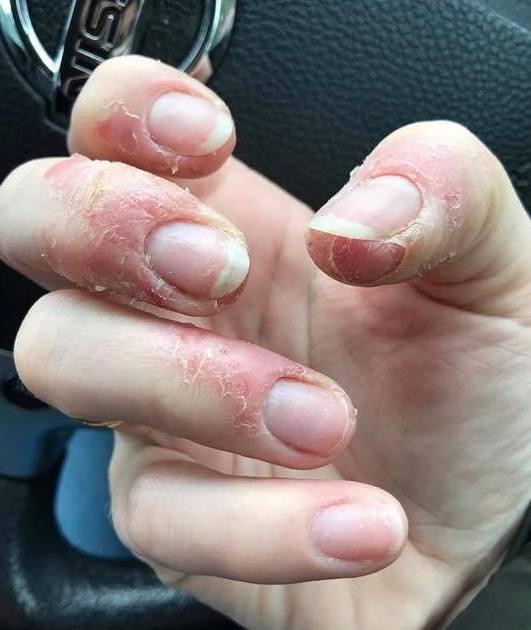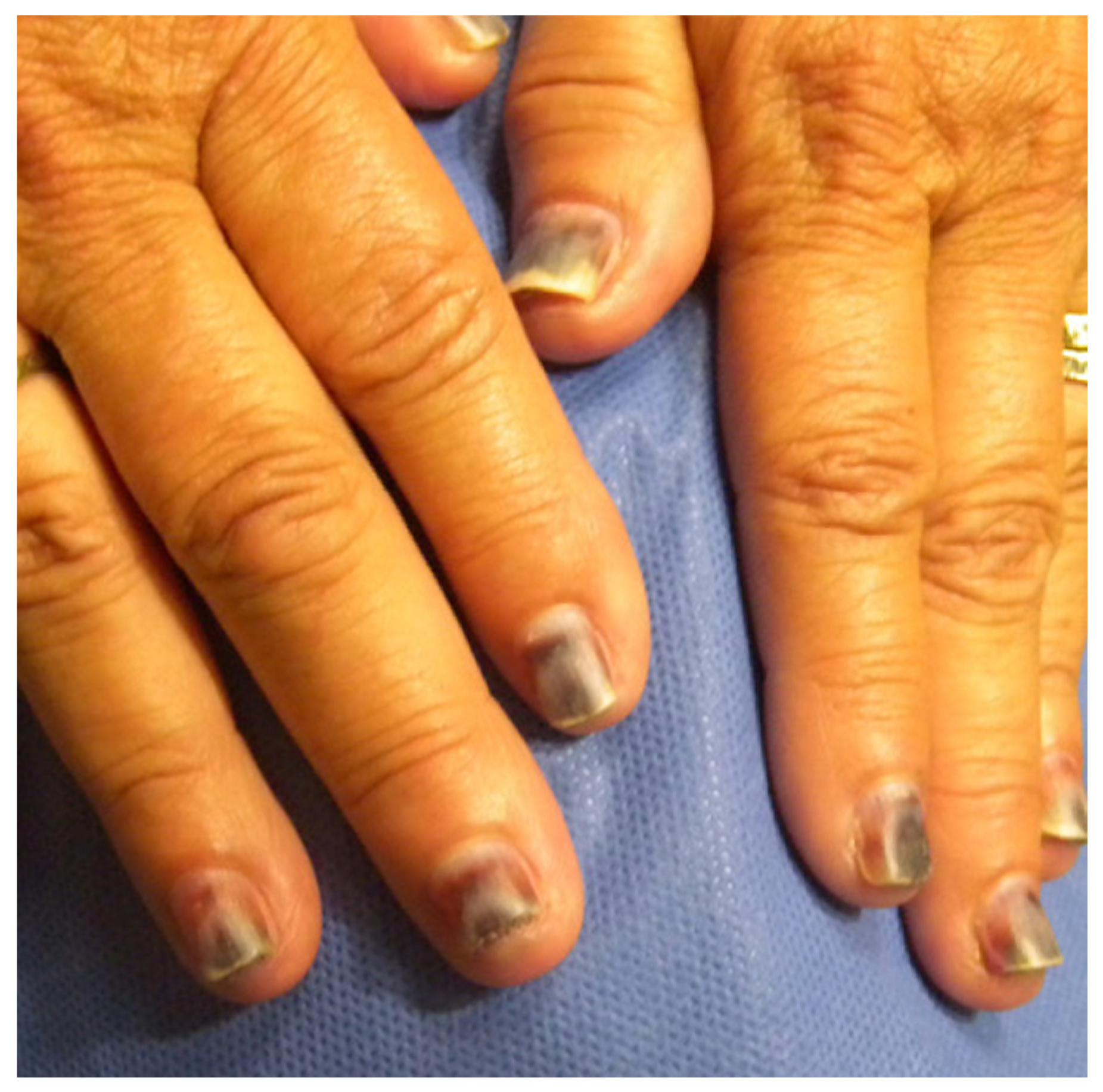Contact Dermatitis & Nail Products: A Growing Trend - Learn Now!
Could your next manicure be a recipe for a skin reaction? Allergic contact dermatitis (ACD) to acrylic nail products is on the rise, posing a significant challenge to both consumers and nail technicians alike.
The world of nail enhancements has exploded in popularity, with gel nail polish (GNP) leading the charge. But this aesthetic trend carries a hidden risk: allergic contact dermatitis (ACD). This isn't just a minor inconvenience; it's a complex immunological response triggered by contact with specific substances. The culprit? Often, acrylates, the workhorses behind the long-lasting shine and durability of artificial nails and gel polishes. As the demand for these services increases, so too does the prevalence of ACD. The impact extends far beyond the salon, affecting consumers and professionals alike, highlighting a growing need for awareness and preventive measures.
The differential diagnosis for skin problems around the nails can be tricky. Conditions like psoriasis and tinea manuum, irritant contact dermatitis, can mimic ACD. Its crucial for dermatologists to differentiate between these, using careful patient history and, when necessary, patch testing to confirm a diagnosis. This is especially important because management strategies will differ greatly depending on the underlying cause. Eczema and psoriasis affecting the nails have their own unique characteristics, with eczema often presenting at any age, while nail psoriasis is more common in older adults.
- Victor Reynolds Train Accident Facts Updates Uncovered Now
- Sone 436 The Elusive Gaming Legend Digital Mystery Unveiled
The diagnosis of ACD is not always straightforward. The initial clues often come from the patient's history and the distribution of the dermatitis. If a patient reports a rash following a manicure or exposure to nail products, and the rashs location aligns with areas of contact, suspicion of ACD should be high. This suspicion must then be confirmed through patch testing. This diagnostic method involves applying small amounts of potential allergens to the skin and observing for a reaction. Once the diagnosis is suspected, it's important to implement recommendations for products with low allergenicity. This can help manage symptoms while awaiting patch testing results. Physicians should refer patients who use or work with nail products for testing if they develop dermatitis, ensuring proper diagnosis and management.
The impact is not limited to the consumer. Nail technicians, who are in constant contact with these products, are particularly vulnerable. Occupational exposure to acrylates can lead to a higher risk of ACD, potentially forcing professionals to leave their careers. These professionals are at the front lines, routinely exposed to a complex cocktail of chemicals. The issue isn't just about aesthetic appeal; it's a potential health crisis that demands attention. Studies have shown that nail technicians face a heightened risk of developing ACD due to their consistent exposure to these chemicals. Several cases have been reported within clinics in recent years, and the overall prevalence is increasing. The cases reported are reflective of a growing trend among nail technicians with allergic contact dermatitis associated with occupational (meth)acrylate exposure. The situation underscores the need for improved training, protective measures, and awareness within the nail industry.
One of the key ingredients of concern is isobornyl acrylate (IBOA), a photopolymerizable monomer frequently used in coatings, sealants, glues, and adhesives. Although the effects of IBOA are well known in other fields, such as causing ACD in users of glucose monitors and insulin pumps, a recent case has expanded its impact, identifying IBOA as an allergen in nail glue. This broadening of the allergen spectrum highlights the diversity of acrylate exposure. Several ingredients in nail cosmetic products are capable of sensitizing patients immune systems and leading to contact dermatitis (CD). This is why thorough patch testing is essential to pinpoint the specific triggers and guide appropriate management strategies.
- Blue Salt Trick Unlocking Male Vitality Secrets 2024 Guide
- Thomas Beaudoins Injury Updates Recovery Amp Resilience In The Spotlight
The history of ACD related to nail products is lengthy. The first documented case of ACD caused by acrylic materials in artificial nails was back in 1956. Although the prevalence of contact allergies to artificial nails was still relatively infrequent in 2014, several occupational cases of contact dermatitis from acrylic nails were reported in beauticians and even one case in a flamenco guitar player. Research continues to identify the frequency and clinical features of ACD in nail cosmetics.
When encountering a rash or irritation related to nail products, it's crucial to be aware of all potential causes and their triggers. The diagnosis starts with understanding the history of the patient. Symptoms might occur in the proximal nail fold (pnf) and the hyponychium. Allergic reactions, are caused by chemicals such as acrylates. Contact dermatitis in the nail apparatus often involves the proximal nail fold (PNF) and the hyponychium, causing both skin changes and nail plate abnormalities. While nail eczema can appear at any age, nail psoriasis typically shows up in older adults. Thumb sucking can also be a factor, especially in young children.
The focus has shifted from individual ingredients to encompass the entire cosmetic product line. "A good example of allergic contact dermatitis is a rash that develops after contact with the acrylates present in nail enhancement products or paraphenylenediamine (PPD) in hair dye." It's important to identify all allergens. Both consumers and professional nail technicians may be affected, leading to occupational ACD in some cases. The rising trend in allergic contact dermatitis caused by acrylates in nail products, affecting both nail technicians and consumers, highlights a growing concern.
The prevalence of allergies is growing, and it is essential for nail technicians and consumers alike to be aware of the risk factors, symptoms, and available solutions. Contact dermatitis can manifest as a rash on the skin, swelling around the nails, or changes to the nail plate itself. Early detection and diagnosis are key to preventing serious complications. For those already experiencing symptoms, it's vital to consult with a dermatologist for proper evaluation and treatment.
- Subhashree Sahu Mms Privacy Concerns Viral Video Details
- David Stirlings Sas Wife Untold Story Legacy Revealed

Dermatitis NailKnowledge

Allergies Free Full Text Contact Dermatitis in Nail Cosmetics

Figure 1 from Severe Onychodystrophy due to Allergic Contact Dermatitis